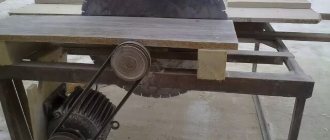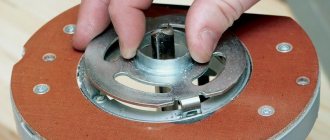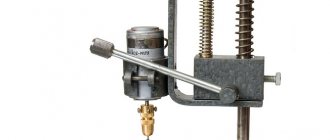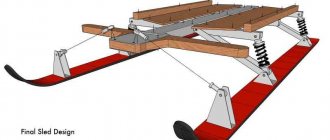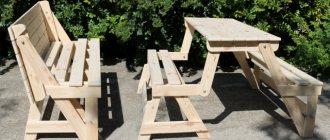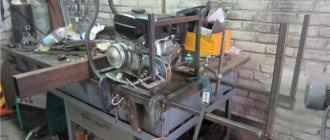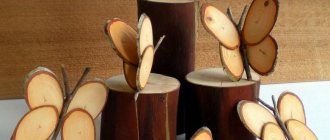Types and their design
The main distinction between all machine equipment is based on the type of drive:
- Manual. It is driven by ordinary human power. These are primitive, but quite effective devices with minimal accuracy and no costs.
- Mechanical. It implies the presence of a lever with subsequent conversion of pressing force.
- Electromechanical – has an electric motor as a driving force. The use is especially relevant if there is a press at the factory, this is how mass production of parts is stamped.
Simple manual
The thinnest sheets can be evenly bent at any angle in the presence of metal (wooden) stops (clamps) and a traverse. This means that the lid, which covers the upper section, producing a bend, is applied solely by hand force without any additional amplifier. Let's look at the design of a homemade sheet bender in the diagram:
Powerful machine made of brands
This is a device with a pressure beam that can clamp and even cut steel. Usually the equipment has a protractor - this is a disk that allows you to set any pressure angle. A steel sheet is secured to the feed table and then advanced further if necessary. Pressing the handle causes the clamping tee to move, while the bending beam remains in place. Let's look at this sheet bender:
Rollers for steel
There is a device with three shafts, when the workpiece passes between them and bends. If you adjust them (remove and install with different diameters, place them at a larger or smaller distance), you can achieve a different bending radius. The result is not an acute angle, but a smooth wave. This is what it looks like:
Safety precautions
Standard safety precautions require mandatory compliance with the instructions for servicing manual sheet bending machines:
- setting the required bend angles on the limiter;
- control of established data using a protractor;
- checking the correct installation of the working tool;
- neat placement of the bending element on the frame part of the device;
- performing test bending and, if necessary, making adjustments;
- recheck the correct bending.
It is important to monitor the correct progress of all bending operations, as well as timely check the technical condition of the device, keep the sheet bender clean and tidy
How to make a sheet metal bending machine with your own hands according to drawings from what is at hand
Manufacturing the structure can be extremely simple and cheap if you use spare parts from trash lying around in the garage. We may need:
- Any strong steel beams or part of a metal profile for the bed.
- A chain from a bicycle/motorcycle, if an electric drive is installed.
- Shafts from the car that will need to be turned.
Of course, to work with thin sheet metal, sometimes you don’t even need to make equipment; you can simply use the “old-fashioned” method, namely, take a mallet and, leaning the steel against a sharp and hard corner, beat it off.
To understand the process, consider the types of sheet bending machines
There are not as many of them as it seems.
Roller
Additionally, it is called three-roll. As a result of metalworking, smooth curves are obtained on the surface. In this way, pipes and half-cylinders can be created that can be adapted for catch basins, street storm drains and much more. Metal rolling is carried out between rollers that have different radii. One shaft sets everything in motion, while the other two remain supporting.
Press brake
There is a template. It is created from strong metal and is double - that is, a matrix and a punch, which have mirror-opposite curves that complement each other. A blank is placed between the two forms. The lower part is motionless, and the second moves up and down, and when pressed, it lowers with great speed and pressing force. The sheet bends.
Homemade sheet bending machine: mechanism made of traverses
If in the press there is a point impact, then here it is across the entire width of the area. The element is fixed in the clamp, and its edge is bent under the influence of a movable traverse. The advantage is that you can produce parts with any angle - from 0 to 180 degrees. Often the device is equipped with a built-in knife and makes the bed multifunctional.
Roller
The second name is end manual. Designed for processing ends and small areas of sheet metal. Only physical strength is used, so it is not very common and is considered additional.
What are car thresholds made of and what are they intended for?
Thresholds for vehicles are divided into several types. The difference between them is how they are attached to the vehicle and what exactly they are intended for.
Let us examine in detail what types of thresholds for cars there are.
- Fixed. Such thresholds are attached by welding and form an integral body structure. She looks tougher.
- Removable. Unlike non-removable ones, these thresholds are attached to the lower parts of the vehicle body using self-tapping screws or special bolts. They can be either protective or as an additional step.
- Power thresholds are installed on frame SUVs. They are attached to the frame by welding or using special powerful bolts and nuts. This power structure will be much larger than the thresholds on cars that have a monocoque body.
How to make a bending machine with your own hands
You need a steel corner, it needs to be cut into pieces of 1 meter. We take the ball joint holder and cut out holes for the hinges for the movable traverse. Next you need to make a support for opening. Next, we make the second, moving part in a similar way. It is necessary to reproduce it so that there is a minimum gap between the ends and complete accuracy. Pay special attention to the edge - it must be perfectly smooth, since the steel will bend at this point. Next, we screw the handle onto the rotary angle - the mechanism itself is ready. Then you need to install it on a stationary and reliable frame.
Additional accessories
To make the design more convenient, you can use wing bolts instead of regular bolts. They will add “springiness”. You can also use a roller knife and cut along the upper pressure crossbar.
Temporary apparatus according to a simplified scheme
If the above option is stationary, then this one is for temporary work. You can take three corners, fasten two of them together with a regular door hinge, and the third, using a clamp, should be pressed against the workbench, thus ensuring static stability.
Classification of serging equipment by drive type
The simplest, both in its design and in its operating principle, is the manual zigovochny machine. All manipulations with such equipment, as its name suggests, are carried out manually. Such manipulations, in particular, include: pressing shafts with working rollers, for which a special handle located in the upper part of the device is used; scrolling the rollers together with the workpiece sandwiched between them: this action is also performed using a special lever-type handle.
To effectively use the simplest manual type crimping machine, certain skills and dexterity are required, since its operator must simultaneously turn the handle and hold the workpiece in the required position, thereby using both hands. Due to the low power of the drive installed on it, a manual creasing machine can be used for processing sheet blanks whose thickness does not exceed 1.5 mm.
Manual crimping machine is suitable for occasional use in the home workshop
A more powerful, productive, but also more expensive in terms of cost is an electrically driven staking machine. Such zigging machines are most correctly classified as electromechanical equipment, since their design also includes a manual mechanical drive, which ensures compression of the sheet workpiece between the working rollers. Due to the electric drive of such equipment, the working rollers rotate and, accordingly, the rotational movement of the workpiece being processed.
The electric drive of the machine is switched on and off using a foot pedal, so that both hands of the operator always remain free to manipulate the workpiece. The presence of an electric drive, which is equipped with such beading machines, as mentioned above, significantly increases their productivity, which makes it possible to successfully use these machines to equip enterprises producing metal products in large batches. In addition, the power of such a machine allows it to be used for processing sheet metal workpieces, the thickness of which reaches 5 mm.
Electromechanical creasing machines, as a rule, can be equipped with additional devices for processing workpieces of complex configurations
Sealing machines can also be equipped with a hydraulic drive, which further increases the power of the equipment. The technical capabilities of such machines make it possible to successfully use them for processing sheet metal of even fairly significant thickness. The hydraulic drive of this type of beading equipment is responsible for pressing the working rollers to the surface of the workpiece, and their rotation and, accordingly, the movement of the workpiece is provided by an electric drive mechanism. Despite all the advantages that hydraulic crimping machines have, they also have disadvantages: large overall dimensions and significant weight, which is why such equipment is mainly used by large manufacturing enterprises.
How and why to make a sheet metal bending machine with your own hands
Many craftsmen need such a unit. It can be purchased, but the purchased models are characterized by large dimensions, weight, and also high prices. At home, it is not necessary to use electrically driven devices; a manual design is sufficient - it is easy to use, apply and create, and is also quite effective. If you are working with aluminum or thin steel, you can use wooden parts rather than steel parts for the equipment, and make the punches and angles themselves from metal for strength.
Pressure bar
Now let's move on to the design of the clamping bar (pictured above). It is also made from a corner, but is laid on the machine with an upward bend. To ensure that the bar does not bend during operation, reinforcement is welded on - metal jumpers. Small metal platforms are welded at both ends of the strip, in which holes are drilled for bolts.
Another important point is that the edge that faces the bend is cut off to obtain a sharper bend angle.
Listogib: is it difficult to do it yourself?
Most craftsmen claim that preparation and implementation generally takes less than a day, despite the fact that the materials need to be processed, because elements that are often rusty and not quite suitable for the parameters are taken. Next, we present the varieties depending on the ease of assembly.
Types for home use
- Rotary (clamping, with traverses) - quite simple, but take up significant space. They can be prepared from scrap materials. They are most effective when combined with cutting knives.
- Rotary (with rollers) - they are much more complicated, since the elements themselves require preliminary metal processing on turning equipment, and an electric drive is an additional complexity.
How to repair a rotten threshold on a car
Fixed thresholds can also be damaged. This could be a dent or corrosion if the car was used in poor conditions. If a vehicle is constantly in contact with water, dirt or chemicals found on our roads, then naturally the sills will be corroded. When the car is also poorly painted, problems with the wear of the thresholds may arise much earlier than we would like. In most cases, this applies to domestic cars.
Sometimes a dent can be made with your own hands, without any stones. This is elementary; it will be enough to install the jack incorrectly to change the wheel.
To start repairing body sills yourself, you first need to assess how damaged they are. This will make it possible to choose the right tools for future work.
Each car owner can handle minor damage to the body himself.
If you confidently decide to do the repairs yourself, you will need:
- Workbench;
- welding;
- hood;
- several anvils;
- Bulgarian;
- tools for a locksmith.
In order to remove dents or other minor misalignments without damaging the paint on the parts, you will need to make surface repairs using an extractor or plotter. If the dent still remains, you should try to repair it by welding. A rectangular hole is cut out from the side of the threshold. They insert an anvil into it and try to carefully straighten out the dent. When your car has more serious damage, metal will have to be cut out in several places. Then the holes are hidden using patches.
If the thresholds are damaged by corrosion, the damaged area is cut out with a grinder, a pattern is made, a patch is cut out from it, which is then welded.
The most popular design and its improvement
Let's look at the standard diagram of a rotary sheet bender:
We will give some recommendations on how to make structural improvements.
Strengthening the pressure beam
To make the clamp more effective, it must be made heavier. You can weld additional weight on top - another corner or strip of heavy metal.
We increase the reliability of fastenings
Clamps and welded joints are not the best methods for fastening. It is much better and stronger to make two beams with holes, and place a tightening bolt between them.
Design features of zig machines
One zigovochny device is structurally not too different from another. Their main elements - shafts - are located horizontally, vertically or at an angle. Forming rollers are mounted on the shafts, and the workpiece is secured between them. Due to the opposite movement of the main elements, uniform depressions appear on the metal. With their help, the necessary connection is made.
When choosing a crimping machine, you need to pay attention to the following technical characteristics:
- type of drive;
- diameter and overhang of rollers;
- the number of attached pairs of these parts;
- permissible metal thickness;
- machine size.
The smallest rollers are 50 mm in diameter, their number varies from four to six pairs.
An important indicator is roller overhang. It is better to purchase a machine with a maximum reach - up to 350 mm. This will expand the capabilities of sieving equipment.
The permissible thickness of the metal sheet is from 0.5 mm to 4 mm. The crimping machine will not take up much space (with the exception of CNC machines). Such a device can weigh from 17 to 300 kg.
Before starting work, the workpiece is fixed between the shafts and the handle is turned. On manual machines, due to their low power, it may be necessary to pass the workpiece through the rollers several times.
- https://met-all.org/oborudovanie/prochee/zigovochnaya-mashina-ruchnaya-zigovka-svoimi-rukami-chertezhi.html
- https://stankiexpert.ru/stanki/gibochnye-stanki/zig-mashina-svoimi-rukami.html
- https://metalloy.ru/stanki/zigovochnaya-mashina
- https://stanokgid.ru/metall/ruchnoj-zigovochnyj-stanok-svoimi-rukami.html
- https://prostruky.ru/instrumenty-i-oborudovanie/listogib-svoimi-rukami-instrukciya-i-chertezhi-dlya-samostoyatelnoj-sborki.html
- https://promzn.ru/stanki-i-oborudovanie/izgotovlenie-zigovochnogo-stanka.html
This is interesting: Pellet machine: types and features of machines for the production of pellets
How to make a homemade sheet metal bending machine
Let's watch the video instructions:
Isn't it easier to buy
The disadvantages of purchased equipment include:
- high cost;
- standard functions and sizes - you cannot improve the model and customize it for yourself;
- large dimensions.
The simplest way
Even if you don’t have time to do this installation, but you urgently need to bend the edge (end, thin layer), you can attach the workpiece to a hard corner and beat off the ends with a mallet. It's simple, but there are disadvantages:
- the bend is uneven;
- you need to apply a lot of physical strength.
The bar is set like this
The clamping bar is placed on the machine, and a spring is placed in the place where the nut is installed. The handle is installed in place. If it does not press the bar, it is raised above the surface due to the elastic force of the spring. In this position, the workpiece is tucked under it, positioned, and pressed.
Sheet bending machine for thick sheets
The best option is an electrically driven roller machine or a hydraulic press, since it is difficult to bend significant volumes manually and the impact must be quick and massive.
What is the device
This is stationary equipment with the following features:
- made of metal or hard wood;
- dimensions exceed the workpiece;
- there are moving and fixed parts (shafts, dies, punch and matrix).
The rest of the appearance depends on the specific model.
Application area
The devices are used in factories, auto repair shops, and also in households. Installed outdoors and indoors.
Profile bending without turning
If you have enough tools, the machine can be completed without turning. To do this, you need to purchase an aluminum I-beam.
To bend this or that profile, with different sizes, you will need simple tools, or rather a machine called a profile bender. It makes it easy to get the job done.
Thanks to the variety, you can make it yourself or buy it in a store. There is also a significant difference in price, such that every person has the opportunity to purchase it. Use it in production or just in a workshop, for constant work, or to bend a pipe several times, all this does not matter when there is a choice of such machines.
Manufacturing: stages
Let's look at several specific step-by-step tasks.
Development of specifications and drawings
Usually the plan can be found on the Internet, but it should be adjusted to the size of the master so that the tension is distributed evenly across all muscles.
Selection of materials
You will need a wooden block, several channels 10 cm wide, narrower corners for the pressure beam, fastening tools, strong metal for the frame and a comfortable handle.
Design detailing and assembly
Let's look at the steps in the video:
Benefits of homemade
Pros before purchasing:
- Cheap - almost all the parts are available among scrap materials.
- Possibility to make custom sizes.
- Understanding the process, which means easy setup and repair.
In the article we talked about homemade bending machines for sheet metal. We invite you to familiarize yourself with our range of band saw products. for 15 years on the Russian market. During this time, we covered almost all cities of the country. To complete the topic, let's watch another video:
Application area
Most often, crimping machines are used in the construction industry. Using such a device, it is possible to produce a whole range of simply irreplaceable structures: elements of air duct systems, drainpipes, spare parts for heating mains. In this field of activity, manual creasing machines are mainly used. They are relatively cheap and have small dimensions. In addition, you do not need to supply electricity to use them.
Crimping machines are often used to process cylindrical parts. The rollers of such a machine, while passing through the cylinder, make special locks on it, to which other parts are attached. This processing method has less negative impact on the workpiece than the welding process. Another advantage of the zig machine is the lack of need for additional consumables.
In addition, a classic crimping machine can be enhanced with additional equipment that will significantly expand its functionality. Using a modified zig machine, you can perform metal bending and profiling. Zig machines can be manual or equipped with an automated control system.
